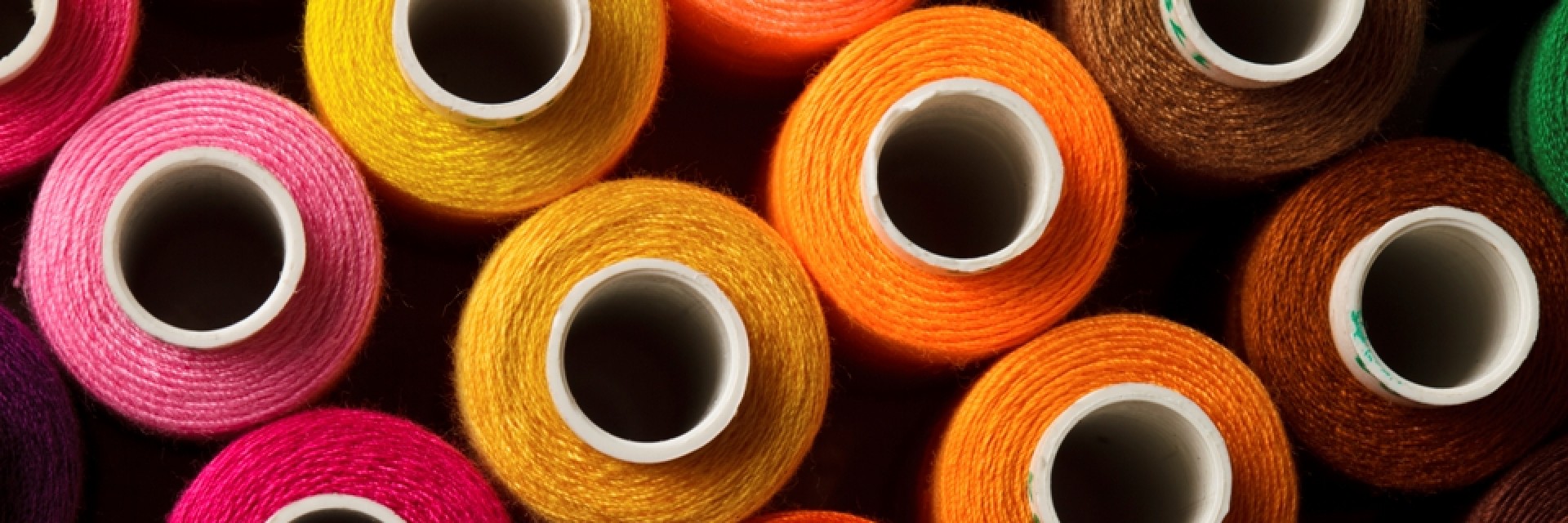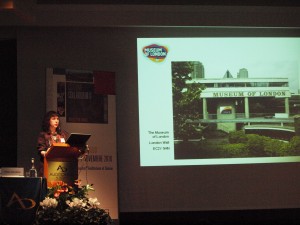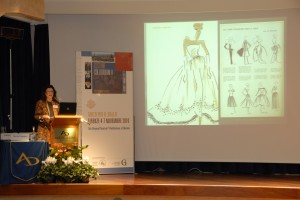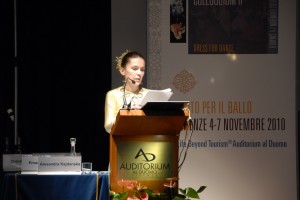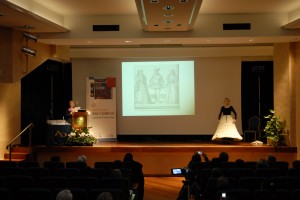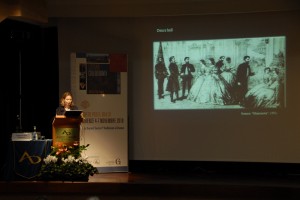PROGRAM:
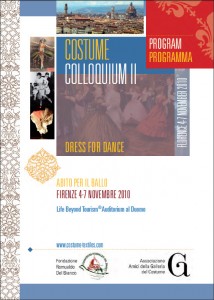 Click here to download the complete program in PDF
Click here to download the complete program in PDF
PRESENTATION ABSTRACTS:
Brandin Barón-Nusbaum (Professor of Design and Design History, University of California, Santa Cruz, USA)
Camargo as Fashion Muse
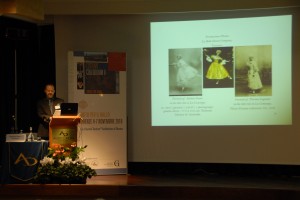 Marie-Anne Cupis de Camargo (1710-1770) was one of the first celebrated soloist ballerinas, and, arguably, France’s first supermodel. Shortly after her debut at the Paris Opéra in 1727, her mastery of the dance steps previously performed only by male dancers necessitated her fashion innovations against the floor-length skirts and unwieldy shoes that female dancers had worn. Camargo’s career as a dancer was greatly enhanced by the explosion of printed imagery documenting her evolving style, blurring the line between performance and the public marketplace. The Camargo “look” provided inspiration for 18th century marchandes de mode and style purveyors, and her imprint influenced many categories of fashionable attire, hairstyles, interior designs and French cuisine. After her death, ideals based on the Camargo mystique have continued to develop new forms of ballet; for more than 200 years, she has remained an iconic figure of dance and fashion history.This visual presentation depicts imagery associated with Camargo, both within an historical context and as a collective, continuing model to inspire present day fashion and costume designers.
Marie-Anne Cupis de Camargo (1710-1770) was one of the first celebrated soloist ballerinas, and, arguably, France’s first supermodel. Shortly after her debut at the Paris Opéra in 1727, her mastery of the dance steps previously performed only by male dancers necessitated her fashion innovations against the floor-length skirts and unwieldy shoes that female dancers had worn. Camargo’s career as a dancer was greatly enhanced by the explosion of printed imagery documenting her evolving style, blurring the line between performance and the public marketplace. The Camargo “look” provided inspiration for 18th century marchandes de mode and style purveyors, and her imprint influenced many categories of fashionable attire, hairstyles, interior designs and French cuisine. After her death, ideals based on the Camargo mystique have continued to develop new forms of ballet; for more than 200 years, she has remained an iconic figure of dance and fashion history.This visual presentation depicts imagery associated with Camargo, both within an historical context and as a collective, continuing model to inspire present day fashion and costume designers.
Christina Bates (Curator of Social History, Canadian Museum of Civilization, Gatineau, Canada)
Right Brain, Left Brain: An Historian Researches and Performs Dance and Dress of Early Canada
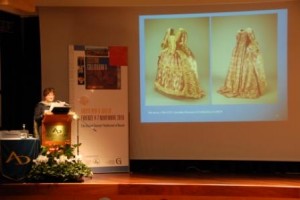 My understanding of the relationship among dance, deportment and dress in eighteenth century Canada is based on traditional documentary research sources such as period accounts, portraits, dance manuals, and original garments. An unconventional additional source is my own body performing eighteenth century dances in period costume. Dance, deportment and dress were essential to creating a cultured society on the frontiers of the New World. Outward appearances played an important role in the political, economic and social milieu of the colonies. An elegant body was an indication of a refined mind and assured character, and as desirable in Canada as in France or England. Structured clothing helped to create the fashionable molded silhouette of the eighteenth century. The rigid corsets, stiff shoes, wide panniers and coattails aided in performing the graceful formality of the minuet and other dances. My understanding of the connection between dance and dress has been greatly enhanced by actually performing the dances in costume. Wearing a corset viscerally demonstrates how a rigid posture was created by flattening and mounding the bosom, and narrowing the shoulder blades at the back. Performing dance shows how this posture was in harmony with the dance aesthetic and stylized movements of torso, arms and feet. This paper will introduce the rich sources and cultural context for dance and dress in early Canada. My approach to the topic combines both rational and experiential investigation, going back and forth from documentary to embodied evidence.
My understanding of the relationship among dance, deportment and dress in eighteenth century Canada is based on traditional documentary research sources such as period accounts, portraits, dance manuals, and original garments. An unconventional additional source is my own body performing eighteenth century dances in period costume. Dance, deportment and dress were essential to creating a cultured society on the frontiers of the New World. Outward appearances played an important role in the political, economic and social milieu of the colonies. An elegant body was an indication of a refined mind and assured character, and as desirable in Canada as in France or England. Structured clothing helped to create the fashionable molded silhouette of the eighteenth century. The rigid corsets, stiff shoes, wide panniers and coattails aided in performing the graceful formality of the minuet and other dances. My understanding of the connection between dance and dress has been greatly enhanced by actually performing the dances in costume. Wearing a corset viscerally demonstrates how a rigid posture was created by flattening and mounding the bosom, and narrowing the shoulder blades at the back. Performing dance shows how this posture was in harmony with the dance aesthetic and stylized movements of torso, arms and feet. This paper will introduce the rich sources and cultural context for dance and dress in early Canada. My approach to the topic combines both rational and experiential investigation, going back and forth from documentary to embodied evidence.
Gillion Carrara (Adjunct Professor and Director, the Fashion Resource Centre, The School of theArt Institute of Chicago, USA)
Soundsuits – Nick Cave in Dance

The rambunctious confluence of multiple aesthetics not only flows but collides and clashes, as it engages the unsuspecting viewer’s senses. Examining a monumental performance of Nick Cave’s signature Soundsuits is always compelling, through his heroic figures meticulously crafted by the visual artist, performer and designer.Imposing head-to-toe figures juxtapose cross-cultural costume, clowning interpretations and dance improvisation. Every decision he makes – from adorning with disparate, often found detritus, to cultural artifacts and their implications, to color and pattern, extravagant shape and cut – is carefully considered.The Soundsuits, his truthful heroes, come alive when worn by dancers in public spaces, art galleries and museums accompanied by percussionists marking the beat, and filmmakers documenting their every move. As an artist, Cave’s objective is to be enthralling, through the color, sparkle and glitter of the immense figures, captivating visitors in mystery and wonder, curiosity, and discomfort.One’s imagination anticipates the figures twirling to the next musical note on which to jump and run in a cacophony of sounds, enrobed by a profusion of layered elements. Cave’s clothing-based forms occupy more than the average person’s space, and extend the body, monumentalizing normality and creating deceptions of the exterior. Many of his recycled elements once served an intentional purpose, in deference to the nature of materials he has scavenged, purchased, or otherwise acquired. Once functional as mundane objects, now they are transformed to become extraordinary instruments that converge as cross-cultural decorative.
Chanel Clarke (Curator of the Maori Collection at Auckland Museum, New Zealand)
From Flax Fiber to Spandex Tights: The Evolution of Maori Costume for Dance
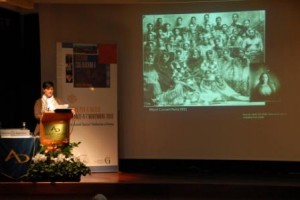
Whilst many publications exist, both past and present, that examine different forms of Maori dance and song, a quick analysis of these reveals that rarely ever is there any discussion about dress in this context. This paper will take as its starting point the five distinct periods of development of Maori music as suggested by Barrow: Traditional, First European, Missionary, Secular, and Modern, and will re-examine these phases with a focus on the evolution of Maori costume for dance from pre-contact times through to the present day. A subsequent post modern period will be added that takes into account the developments that have occurred in New Zealand since the publication of Barrow’s book in the early 1960s. In particular this paper will examine the social and political climate within Maori society and how expressions of Maori identity are manifested through performance and dance and the accompanying costume. The paper will also examine the influence of large scale tourism during the late nineteenth to early twentieth century, on the creation of a standardized costume for dance performance, and how that costume has come to be recognized as a quasi New Zealand national costume both at home and abroad.
Anna Maria Colombo (Scienza e Cultura delle Alpi, Università di Torino, Turin, Italy)
Costume and Traditional Dance in the Communities of Western Alps
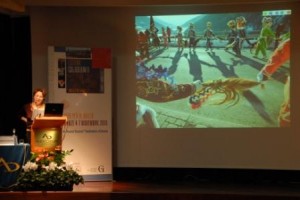
This paper will consider some traditional costumes used in the alpine area during festive occasions in which characteristic dances, such a the sward Dance in Val di Susa, that occurs each year in the month of April in the Municipality of San Giorio, and the Landzette that takes place during carnival in the Valley of Gran San Bernardo. Their fashion, their decorative and chromatic peculiarities that evidence the material and symbolic relationships that the costumes have with “dance movements” will be analyzed. An observation of the success of alpine festivities and of the transformations that are produced in the array of ceremonial textiles will follow.
Hilary Davidson (Curator of Fashion and Decorative Arts, Museum of London, London, UK)
Flying Dancers, Dying Swans and Soho Dives: Dance Costumes at Museum of London
The Museum of London’s collections tell the story of London from the earliest times to the present day. A key part of the dress and textile collections are costumes of dance performers from prima ballerinas to local enthusiasts. This paper explores the rich variety of dance costumes at Museum of London and looks at their history, interpretation and display. Early stage technology is found in the engineered corset for ‘Azella’, the first solo flying dancer. The Ballets Russes premiered works in London, including Le Tricorne Bleu (1921), designed by Picasso and choreographed by Leonide Massine. Other Diaghilev productions such as The Sleeping Princess (1920) and The Firebird are represented. Not only does the Museum hold Anna Pavlova’s costume from her signature work The Dying Swan, but also used shoes and more everyday clothing from her long life in London. In contrast, a collection of dazzling, exotic and very brief beaded outfits worn by dancers at Murray’s Cabaret Club in Soho, a risqué London nightclub, and the stage costumes of turn-of-the-century burlesque performer Kitty Lord, evoke a different experience of the pleasures of performance. In recent times amateur ballroom competitors, Morris dancers and Ugandan drummers have contributed their costumes that show different facets of dance. By exploring these physical legacies of costume, and more, the spectrum of the capital’s rich dance history comes to life.
Marilyn Revell DeLong (Professor of Apparel Studies and Associate Dean for Research and Outreach, University of Minnesota, St. Paul, USA)
Fashionable Dress and Popular Dance in 1930s Hollywood
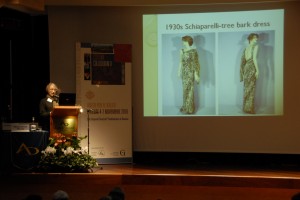 Hollywood musicals were an important venue for fashion in the 1930s, both for what was worn for dancing and as subject matter for films. For example, Fred Astaire and Ginger Rogers were popular dance partners who repeatedly starred in films during this time, and the dancing exploits of this team became a sensation of individual style, music, movement, and fantasy. The idea that movies, even musicals, were an important venue for reviews of fashionable dress was also developed in the 1930s. In one film, Roberta, the story involves the House of Roberta and a designer who in the course of the film display numerous ensembles in a musical fashion show. The purpose of such a film on fashion was to provide luxurious inspiration for movie audiences. The aesthetics of dress of 1930s Hollywood includes analysis of dress worn in specific musicals analyzed in terms of their form, i.e., line, shape, surface, texture, and color. For example, the smooth curve of beauty under absolute control was an advertising promise of the woman who used the proper foundation garments. The famous light blue ostrich-feather dress (now in the Smithsonian) that Ginger wore dancing with Fred in the film, Top Hat, was sensational but also problematic in its materiality, e.g. floating feathers needed to be anchored, the pale color needed to be balanced with the black top hat and tails worn by her partner. Analysis of context involves consideration of the physical surrounding and cultural milieu (DeLong, 1998) and ranges from the blending of dance movements, the motif of tap dancing, the words and music of the dance numbers in the specific films, then broadening to an examination of Hollywood in the 1930s. The back focus of Ginger’s dress, especially in ‘dancing cheek to cheek’ with Fred (Gallafent, 2000) was also found in many 1930s evening dresses used for dancing with a partner. Meanings are related to dance and fashion and to influential style trends such as Art Deco and Streamlining. Ginger’s pale blue feather dress used for dancing was successful in large measure due to opposing associations of suggestiveness and innocence (Berry, 2000). Fantasy and luxury were themes of the 1930s that repeated in dressing for dance and in the fashions exhibited in movies. Once the analysis of aesthetics is completed, the paper will extrapolate to actual evening dress of the 1930 as located in a museum collection (DeLong & Petersen, 2004). Based upon the analysis of 1930s Hollywood, the study considers the essence of fashionable dresses related to the aesthetics and how these are revealed in other extant evening dresses of the period. In this way the author concludes how the form, context, and meaning of fashionable dress and popular dance were characteristic of the 1930s.
Hollywood musicals were an important venue for fashion in the 1930s, both for what was worn for dancing and as subject matter for films. For example, Fred Astaire and Ginger Rogers were popular dance partners who repeatedly starred in films during this time, and the dancing exploits of this team became a sensation of individual style, music, movement, and fantasy. The idea that movies, even musicals, were an important venue for reviews of fashionable dress was also developed in the 1930s. In one film, Roberta, the story involves the House of Roberta and a designer who in the course of the film display numerous ensembles in a musical fashion show. The purpose of such a film on fashion was to provide luxurious inspiration for movie audiences. The aesthetics of dress of 1930s Hollywood includes analysis of dress worn in specific musicals analyzed in terms of their form, i.e., line, shape, surface, texture, and color. For example, the smooth curve of beauty under absolute control was an advertising promise of the woman who used the proper foundation garments. The famous light blue ostrich-feather dress (now in the Smithsonian) that Ginger wore dancing with Fred in the film, Top Hat, was sensational but also problematic in its materiality, e.g. floating feathers needed to be anchored, the pale color needed to be balanced with the black top hat and tails worn by her partner. Analysis of context involves consideration of the physical surrounding and cultural milieu (DeLong, 1998) and ranges from the blending of dance movements, the motif of tap dancing, the words and music of the dance numbers in the specific films, then broadening to an examination of Hollywood in the 1930s. The back focus of Ginger’s dress, especially in ‘dancing cheek to cheek’ with Fred (Gallafent, 2000) was also found in many 1930s evening dresses used for dancing with a partner. Meanings are related to dance and fashion and to influential style trends such as Art Deco and Streamlining. Ginger’s pale blue feather dress used for dancing was successful in large measure due to opposing associations of suggestiveness and innocence (Berry, 2000). Fantasy and luxury were themes of the 1930s that repeated in dressing for dance and in the fashions exhibited in movies. Once the analysis of aesthetics is completed, the paper will extrapolate to actual evening dress of the 1930 as located in a museum collection (DeLong & Petersen, 2004). Based upon the analysis of 1930s Hollywood, the study considers the essence of fashionable dresses related to the aesthetics and how these are revealed in other extant evening dresses of the period. In this way the author concludes how the form, context, and meaning of fashionable dress and popular dance were characteristic of the 1930s.
Aurora Fiorentini (Professor of Fashion and Dress, Università di Firenze, Florence, Italy)
The ‘Haute Couture’ Dancing Dress in the Cinema of the Fifties and the Sixties. The Exemplar Case of Hubert de Givenchy: from “Sabrina” (1954) to “Breakfast at Tiffany’s” (1961)
This proposal was born thanks to a precedent study that, in the spring 2009, took me to Paris to meet directly the great couturier Hubert de Givenchy, who demonstrated to be a person of great charm and very open to analyze closely some topics related with his career and his work. If his health will permit it, I plan to go back to interview him on a topic very important that often emerged from our conversations: his personal contribution as a couturier to the international cinema. Talking of Audrey Hepburn, we can see that, maybe his has been the first evident example in which, an emerging actress not yet popular, had consolidated her personality and an unmistakable style thanks to the masterly contribution of a high fashion couturier instead of the one of a manager or a cinema costume designer. Not only this. Givenchy opened also the way to other more recent but equally celebrated combinations between stylists, actors and/or directors. His long lasting collaboration with the cinema started in 1953 and continued way after the middle Seventies of the 20th Century, interacting not only with the Hollywood star system but also with famous directors, producers and actresses from England and France. This proposal was born thanks to a precedent study that, in the spring 2009, took me to Paris to meet directly the great couturier Hubert de Givenchy, who demonstrated to be a person of great charm and very open to analyze closely some topics related with his caree However, what makes him unanimously remembered today, with continuous quotation in the contemporary fashion world, is his imposition of a new cliché to the feminine elegance, more essential and modern compared to the one in use in that time in the world of cinema costume designers. Starting from Givenchy the stylistic contribution of fashion couturiers is more evident compared to the one proposed by the renown costume designers, suggested by the great American production companies. Givenchy is attributed with the epochal change in the silhouette of the ball gowns. Already starting in Sabrina (1954) it appears on the protagonist with a new interpretation, absolutely different from the one given to the co-protagonists of the movie and also, I would say, to the one given to the rest of the international cinematography. Fundamental is the break that is realized, in few frames, between the taste of the American upper middle class and the one of the Cinderella transformed in “queen” by the matchless Parisian glamour. Givenchy demonstrates the ability to interact perfectly with the black and white movie filmed by Billy Wilder by choosing in a very precise way the style of the dress and its decorations, that are magnified by the absence of color and by the use of the monochrome picture. It is demonstrated within few years how a toilette, as codified as the one of the ball dress, could be stylized more and more to arrive to its climax in Breakfast at Tiffany’s (1861) and passing through some important examples displayed in Love in the Afternoon (1957) and Funny Face (1957). In the movie by Blake Edwards various are the sartorial solutions proposed by Givenchy with great modernity, together with an innate taste for design. Among all, the most renowned remains the long black dress with which the movie starts. Even if filmed in Technicolor Givenchy prefers, this time, together with some touches of pastel colors, to create a decisive use of the black with a new and untypical function. The elegant silhouette becomes a dark spot, a clean and essential outline, almost rarefied, through a process of abstraction that transforms the evening dress into a concept. The dress isn’t subdued anymore to the conventional rules of the show business that, traditionally, saw it as the most sumptuous and showy dress in the wardrobe of the main actress. The detailed analysis of the dresses and their cinematographically function will take place during the event, with an exhaustive roundup of significant movies.
Joseph Fontano (Choreographer & President of World Dance Alliance Europe, Rome, Italy)
Dancing within Ready Made Materials
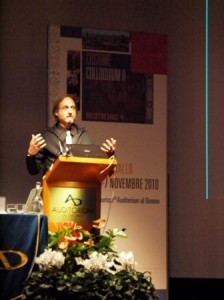
I have always thought of the art of dance as a “visual art” giving me, as a choreographer the liberty to create a “total look” and not just costume or dance wear. Colour, texture, lighting and “material” are the most important aspects for costumes. A dancer is a complete transgression of the human body. Form and shape are produced through movement giving to an audience a sublime experience of movement of the artist within its costume. Whether the dancer is moving or still for a moment, the costume gives the idea of being “part” of what is occurring, it captures both movement and the body. I’ve always created my lighting and almost in every occasion organised my own costumes. I’ve found myself using, paper, plastic, pasta, curtains, and many things “ready made”. These materials are used as a support to my creativity in the movement that I am conceiving. The materials are sewed, pinned, glued, attached, tied, wrapped around or sometimes just placed on to the dancer. Skirts are made of plastic enhanced by pasta that has been coloured held together by a “rope around the waste”. My last productions have seen a dancer within “plastic” that is used to pack plates and dishes. Another work has seen newspaper, held together by tape, large as a stage floor that is then wrapped around the dancer forming a spiral. It becomes a dress, a house and a place to stay within and an ambience to break away from.
Sam Gatley (Textile Display Specialist, Victoria & Albert Museum, London, UK
with Cynthea Dowling (Costume Mounting & Display Specialist, Victoria & Albert Museum, London, UK)
Dressing for the Ballet: Displaying Costume from the Ballet Russes
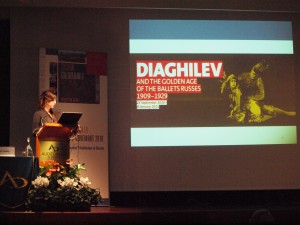 Diaghilev and the Ballet Russes is a major exhibition organized by the Victoria and Albert Museum (V&A). The exhibition will open at the V&A in September 2010 and subsequently tour to venues in Europe and the US. The exhibition, which commemorates the centenary of Diaghilev’s Ballet Ruses arriving in London, will feature fifty of the V&A’s world class collection of original costumes. Many challenges are faced in the mounting and display of any museum dress but several became more pronounced when working with this collection of dance costume. One of those challenges was how to achieve a sense of movement within the display. The condition of the Ballet Russes collection made this difficult if not impossible due to the original ephemeral nature and subsequent material degradation of the items. Many garments have become extremely fragile and distorted as a result of heavy wear and tear and perspiration staining during use. This has been compounded by poor storage and a general lack of care associated with the life of a performance costume prior to being bought into the museum collection. By selecting a number of complex case studies the aims, processes and challenges involved with preparing costume for this display will be discussed.
Diaghilev and the Ballet Russes is a major exhibition organized by the Victoria and Albert Museum (V&A). The exhibition will open at the V&A in September 2010 and subsequently tour to venues in Europe and the US. The exhibition, which commemorates the centenary of Diaghilev’s Ballet Ruses arriving in London, will feature fifty of the V&A’s world class collection of original costumes. Many challenges are faced in the mounting and display of any museum dress but several became more pronounced when working with this collection of dance costume. One of those challenges was how to achieve a sense of movement within the display. The condition of the Ballet Russes collection made this difficult if not impossible due to the original ephemeral nature and subsequent material degradation of the items. Many garments have become extremely fragile and distorted as a result of heavy wear and tear and perspiration staining during use. This has been compounded by poor storage and a general lack of care associated with the life of a performance costume prior to being bought into the museum collection. By selecting a number of complex case studies the aims, processes and challenges involved with preparing costume for this display will be discussed.
Key subjects addressed include:
– Historical context, materials and construction
– The effects of time and wear on dance costume
– Practical mounting considerations for the display of costume
– Interpretation of dance costume through mounting
– Use of reproduction accessories
John Hoenig (Theatre and Event Director, Renaissance Scholar, Florence, Italy)
with Teresa Pasqui (Professor of Fashion and Costume Design, University of Florence and the Istituto d’Arte, Florence)
A Talent to Amaze – Bernardo Buontalenti’s Costume Designs for the Intermedi of 1589
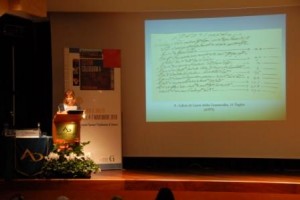 The month-long festivities held in Florence in 1589 for the marriage of Ferdinando de’ Medici to
The month-long festivities held in Florence in 1589 for the marriage of Ferdinando de’ Medici to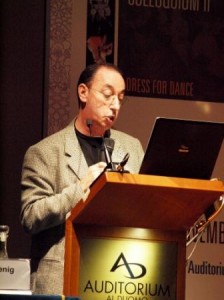 Christine of Lorraine, culminated on 2nd May with a performance staged at the Medici Theatre in the Uffizi. This consisted of six Intermedi by Giovanni de’ Bardi dei Conti di Vernio, and directed by Emilio dei Cavalieri, which was performed between the acts of the commedia ‘La Pellegrina’ by Girolamo Bargagli. This was just part of a series of theatrical events produced on a scale comparable today to an Olympic opening ceremony and arts festival combined. This allegorical display of power and magnificence is considered to be a landmark in arts patronage and the Intermedi were remarkable for heralding the transition from music theatre to opera, integrating dance and ‘marvelous’ visual spectacle. The complexity of design and production out-shone any previously performed extravaganza. In addition to designing the theatre, machinery and scenery, Bernardo Buontalenti, the creative Medici court architect, supervised the creation of 286 costumes by over 50 tailors. Numerous original drawings still survive. These works of singular vision and imagination directly influenced theatre design to follow (Giulio Parigi, Inigo Jones). It is fortunate that much written, visual and musical documentation has survived which recent research has brought to light. The official Festival Books and first-hand contemporary accounts of the design, construction, rehearsals and performances, offer much detail on the eighteen-month long production process. The “Libro di Conti della Commedia” (Book of Accounts), preserved in the “Florence State Archives”, is an important original document which serves as an instrument for the study of theatrical costume history. It reveals details about the frenetic preparations, the daily acquisitions, the awaited consignments, the astounding quantity of materials purchased together with the techniques of the many tailors and embroiderers working behind the scenes on the creation of the magnificent theatrical costumes. Hoenig and Pasqui’s presentation will combine their knowledge and research of theatre and costume history to give an insight into the amazement that this singular historic event created for all those who saw it.
Christine of Lorraine, culminated on 2nd May with a performance staged at the Medici Theatre in the Uffizi. This consisted of six Intermedi by Giovanni de’ Bardi dei Conti di Vernio, and directed by Emilio dei Cavalieri, which was performed between the acts of the commedia ‘La Pellegrina’ by Girolamo Bargagli. This was just part of a series of theatrical events produced on a scale comparable today to an Olympic opening ceremony and arts festival combined. This allegorical display of power and magnificence is considered to be a landmark in arts patronage and the Intermedi were remarkable for heralding the transition from music theatre to opera, integrating dance and ‘marvelous’ visual spectacle. The complexity of design and production out-shone any previously performed extravaganza. In addition to designing the theatre, machinery and scenery, Bernardo Buontalenti, the creative Medici court architect, supervised the creation of 286 costumes by over 50 tailors. Numerous original drawings still survive. These works of singular vision and imagination directly influenced theatre design to follow (Giulio Parigi, Inigo Jones). It is fortunate that much written, visual and musical documentation has survived which recent research has brought to light. The official Festival Books and first-hand contemporary accounts of the design, construction, rehearsals and performances, offer much detail on the eighteen-month long production process. The “Libro di Conti della Commedia” (Book of Accounts), preserved in the “Florence State Archives”, is an important original document which serves as an instrument for the study of theatrical costume history. It reveals details about the frenetic preparations, the daily acquisitions, the awaited consignments, the astounding quantity of materials purchased together with the techniques of the many tailors and embroiderers working behind the scenes on the creation of the magnificent theatrical costumes. Hoenig and Pasqui’s presentation will combine their knowledge and research of theatre and costume history to give an insight into the amazement that this singular historic event created for all those who saw it.
Mimi Maxmen (Costume Designer, New York City, USA)
with Holly Hynes (Costume Designer, New York, USA)
As Designers we will discuss the following questions:“See the Music. Hear the Dance”
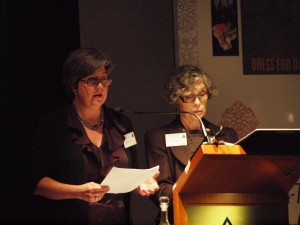 This joint presentation will illustrate the quote above by George Balanchine by demonstrating how costume designers use Balanchine’s inspiring quote to design specifically for dance. Costumes designed to move, to move comfortably on dancers and to communicate character without speech, require a distinct approach when compared to those designed for theatre. We will examine this phenomena in several ways. Together we will draw on our extensive design and creation experiences. Ms. Hynes will share her vast experience while “playing in Karinska’s closet,” including and her expert restoration and recreation of several of Karinska’s most famous ballet designs. We both have designed Shakespeare’s A Midsummer Night’s Dream for theater and ballet. Together, we will use it to illustrate the similarities and differences between theater and dance costume design and creation. Our visual presentation will include original sketches, production photos, and photographs of actual costumes.
This joint presentation will illustrate the quote above by George Balanchine by demonstrating how costume designers use Balanchine’s inspiring quote to design specifically for dance. Costumes designed to move, to move comfortably on dancers and to communicate character without speech, require a distinct approach when compared to those designed for theatre. We will examine this phenomena in several ways. Together we will draw on our extensive design and creation experiences. Ms. Hynes will share her vast experience while “playing in Karinska’s closet,” including and her expert restoration and recreation of several of Karinska’s most famous ballet designs. We both have designed Shakespeare’s A Midsummer Night’s Dream for theater and ballet. Together, we will use it to illustrate the similarities and differences between theater and dance costume design and creation. Our visual presentation will include original sketches, production photos, and photographs of actual costumes.
As Designers we will discuss the following questions:
– How do music and movement influence our designs?
– How is character created when it isn’t written?
– How are non-traditional characters designed?
For example; a character as described as a Variation or Divertissement?
As Creators we will discuss the following questions:
– How are period costumes made for a modern dance company?
– How are beautiful costumes made to survive lights, sweat, partnering and makeup?
How we, as costume designers and creators, interpret and communicate the choreographer’s vision through costume is how we will lead the audience to “See the music. Hear the dance.”
Jennifer Irwin (Costume Designer, Sidney, Australia)
Design for Contemporary Indigenous Dance in Australia: Bangarra Dance Theatre.
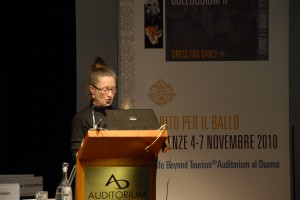 Jennifer Irwin is Australia’s most prolific contemporary dance costume designer. Her work has made a significant contribution to the way in which contemporary indigenous dance has evolved its own distinctive visually arresting style which sensitively incorporates traditional forms with cutting edge contemporary styling. Traditional forms of dance which have been continuously performed for over 60’000 years. This presentation illustrates highlights from Irwin’s portfolio of the last 20 years, focusing particularly on her work with contemporary indigenous dance. Her work with the internationally successful Bangarra Dance Theatre (which has toured Italy) shows how artistic collaborations in dance can cross cultural boundaries and explore themes such as tradition, cultural dislocation, post colonial identities and the revision of historical ‘truths’.
Jennifer Irwin is Australia’s most prolific contemporary dance costume designer. Her work has made a significant contribution to the way in which contemporary indigenous dance has evolved its own distinctive visually arresting style which sensitively incorporates traditional forms with cutting edge contemporary styling. Traditional forms of dance which have been continuously performed for over 60’000 years. This presentation illustrates highlights from Irwin’s portfolio of the last 20 years, focusing particularly on her work with contemporary indigenous dance. Her work with the internationally successful Bangarra Dance Theatre (which has toured Italy) shows how artistic collaborations in dance can cross cultural boundaries and explore themes such as tradition, cultural dislocation, post colonial identities and the revision of historical ‘truths’.
Alexandra Kajdanska (Dance Teacher & Costume Historian, Gdansk-Oliwa, Poland)
Dance Costume in Yunnan: From Ritual Dance to the Modern Dance Drama
The Yunnan province in China is a home of 27 different ethnical minorities with different cultural roots, customs, costumes and dances. Due to the favorable climatic conditions and fertility of soil, people there are cheerful and friendly and like to spend free time: singing and dancing. Yunnan is known for its numerous festivals attracting visitors from all China and abroad. The object of my research is to examine different Yunnan dances and their costumes on the background of the general history of dance in China from the Tang Dynasty when she was so opened to the influences of foreign cultures and trends. I also investigate the changes concerning dances and their costumes from old times, when they were parts of different rituals, to the modern ethnical dances and dance dramas with new choreographies and costumes. As an example can be quoted the history of modern Dai minority Peacock dance, traditionally done by one man (sorcerer) who wore crested bird mask (niaomianju) and had attached great wings to this hands. Now it is graceful feminine solo dance (known internationally in the modern choreography and costume (kongquefu) of a talented Bai nationality dancer Yang Liping), as well as a core of wellknown dance dramas (Zhaoshutun and Nanmuruona) performed by the Dance Ensemble of Xishuanbanna or Ashima, based on traditional folk Yi nationality forms with their fashionable costumes and with techniques adopted even from ballet, successfully combining traditional and modern art.
Helena Kazárová (Researcher/Choreographer of 17th-18th Century Dance and Associate Professor of Dance and Ballet History and Aesthetics, Academy of Performing Arts in Prague, Czech Republic)
Dance and Time – Costumes for Dance in Český Krumlov Baroque Theatre Collection
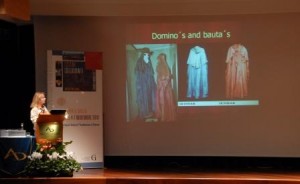
In the depository of the Ducal Theatre of Český Krumlov Castle (South Bohemia, Czech Republic) survives a huge collection of theatre costumes and shoes (around 600 pieces). Many of them were used for dance in the period from 1740 to 1900. My presentation will introduce the most interesting of them together with the known connections of these costumes to the theatre activities of the Princes of Schwarzenberg, who used this theatre in the period from 1766-1900 and who were also passionate dancers and actors themselves. Thus most of the pieces of this worldly unique collection represent their own costumes. As the Schwarzenbergs had also a palace in Vienna and were very much involved in the theatrical activities there, there is a strong connection to the dance fashion of the Central Europe as such. The costumes could be divided in following types: the heroic ballet costumes, the pastoral costumes, the occupational and character costumes, the commedia dell’arte costumes and the exotic costumes. In the Castle Archive also some of the inventories survived, so we can also compare the changing description of these costumes through the time. Many of the costumes are children costumes, as children of the nobility often appeared in the ballets-pantomimes at Český Krumlov Castle Theatre. All of the costumes were sewn by hand and have very interesting cuts. The oldest ones are embroidered with silver thread etc.
Donatella Lippi (Professore Associato Storia della Medicina, Università di Firenze, Florence, Italy)
Dance and Therapeutic Knots
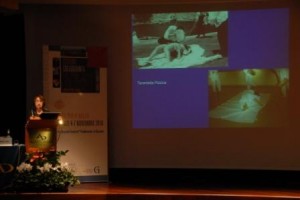 According to some old written documents, the “Tarantism” was an obscure illness which was epidemic in southern Italy between the 15th and the 17th centuries. It was supposedly provoked by the bite of a poisonous spider which inhabits the Apulian hills, called a “tarantula” (Lycosa tarentula). There were strong suggestions that there is no organic cause for the heightened excitability and restlessness that gripped the victims, but there is not an unanimous interpretation: however it is generally agreed that the dire living conditions of the late Middle Ages – natural disasters, the Black Death, famine, social unrest – made Europeans seek relief in ‘the intoxication of an artificial delirium’. The stated belief of the time was that victims needed to engage in frenzied dancing to prevent death from Tarantism. Supposedly a particular kind of dance, called the Tarantella or pizzica, evolved from this therapy. During the ritual, the girl dancer moves rhythmically, rolling back and forth across the bleached linen sheet before coming to her feet to dance steps of the pizzica within the sheet’s contours. Eventually, she collapses gently to the ground only to repeat this sequence several time until the musicians come to the end of their piece. Considered both sacred and therapeutic, it was performed by peasants as a street dance and the trance was induced by music. The dancers used to wear white dresses and coloured ribbons which allude to the sphere of nervous diseases as epilepsy and possession by the devil were treated by music and coloured knots. In fact it was believed that the disease was fastened in the ribbon through the magic knot.
According to some old written documents, the “Tarantism” was an obscure illness which was epidemic in southern Italy between the 15th and the 17th centuries. It was supposedly provoked by the bite of a poisonous spider which inhabits the Apulian hills, called a “tarantula” (Lycosa tarentula). There were strong suggestions that there is no organic cause for the heightened excitability and restlessness that gripped the victims, but there is not an unanimous interpretation: however it is generally agreed that the dire living conditions of the late Middle Ages – natural disasters, the Black Death, famine, social unrest – made Europeans seek relief in ‘the intoxication of an artificial delirium’. The stated belief of the time was that victims needed to engage in frenzied dancing to prevent death from Tarantism. Supposedly a particular kind of dance, called the Tarantella or pizzica, evolved from this therapy. During the ritual, the girl dancer moves rhythmically, rolling back and forth across the bleached linen sheet before coming to her feet to dance steps of the pizzica within the sheet’s contours. Eventually, she collapses gently to the ground only to repeat this sequence several time until the musicians come to the end of their piece. Considered both sacred and therapeutic, it was performed by peasants as a street dance and the trance was induced by music. The dancers used to wear white dresses and coloured ribbons which allude to the sphere of nervous diseases as epilepsy and possession by the devil were treated by music and coloured knots. In fact it was believed that the disease was fastened in the ribbon through the magic knot.
Jackie Marshall-Ward (Researcher, Performer, Teacher and Director of Dance Royal and Hands on History, UK)
Dance for Dress or Dress for Dance: Clothing or Costume?
Antonius Arena wrote in the 16th century, “When you are dancing, always wear your most elegant clothes.” He was advising the would-be courtier for whom dancing was an essential social accomplishment, providing the opportunity to impress both his peers and superiors when appearance and status were inseparable and the only dance professionals were the dancing masters retained at court. Their works provide steps and choreography in minute detail to enable accurate recreation of the dances. But what should be worn? There was no requirement to create a “costume”. The dancer was presenting himself, wearing his most spectacular “clothes.” For him, the dance is the ideal vehicle for display and steps and style are subservient to what is being worn. To recreate such dances truthfully we must hold fast to this premise, working within the constraints of the clothing. So – what of “costume”? Records exist from earliest times of entertainments requiring participants to be other than themselves. “Clothing” is created for a specific purpose and becomes “costume”. It is worn only for performance and hence the limitations of contemporary fashion can be set aside thus allowing for the greater physicality of the professional. Within the spectrum of dance in history a distinction must be made between social and professional dance. In order to present the former with authenticity it is essential to wear the appropriate clothes recreated with reference to the work of Janet Arnold and others in order to feel how to move. Social dancers today are largely amateur and wear clothes. Conversely, the dress of dance professionals is totally specific to their performance and could serve no other function. So – is it dance for the dress or dress for the dance?
Barbara Menard Pugliese (Dance Historian and Director, Commonwealth Vintage Dancers, Boston, USA)
Recreating the Nineteenth Century Ballroom
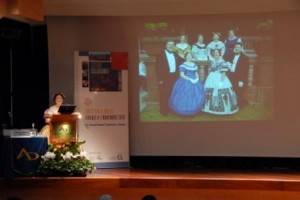 Over the last 30 years the Vintage Dance movement has sought to revive historical social dance in America. Dozens of groups of enthusiasts have come together to recreate and perform the dances of the nineteenth and early twentieth centuries. The Commonwealth Vintage Dancers has been researching, reconstructing and recreating these dances for the last 26 years. From the start, they decided it was important to wear period correct clothing for each dance era. All
Over the last 30 years the Vintage Dance movement has sought to revive historical social dance in America. Dozens of groups of enthusiasts have come together to recreate and perform the dances of the nineteenth and early twentieth centuries. The Commonwealth Vintage Dancers has been researching, reconstructing and recreating these dances for the last 26 years. From the start, they decided it was important to wear period correct clothing for each dance era. All
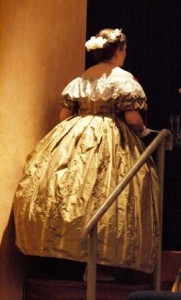 dresses are constructed using the best current knowledge of period sewing techniques. Corsets have always been mandatory for women dancers. This attention to detail extends to the balls that they sponsor. For a given ball, all music, dance and even refreshment recipes are coordinated for a specific target date, for example 1892. The performers wear formal clothing from that year. Attendees are encouraged to wear clothing appropriate to that year, or modern semi-formal dress. This paper will discuss the ways in which the correct clothing influences our dance reconstructions. For instance, we have found that reproduction clothing helps emphasize the differences between an 1860s and 1890s schottische. The movement of period undergarments and fabrics influences how a dancer chooses to cushion each leap or hop and thus helps bring our recreation of the dance closer to the way it was originally performed. Likewise, historically accurate clothing influences the behavior of everyone in our modern 19th century ballroom, giving us a more complete sense of what these dances were like in their original context.
dresses are constructed using the best current knowledge of period sewing techniques. Corsets have always been mandatory for women dancers. This attention to detail extends to the balls that they sponsor. For a given ball, all music, dance and even refreshment recipes are coordinated for a specific target date, for example 1892. The performers wear formal clothing from that year. Attendees are encouraged to wear clothing appropriate to that year, or modern semi-formal dress. This paper will discuss the ways in which the correct clothing influences our dance reconstructions. For instance, we have found that reproduction clothing helps emphasize the differences between an 1860s and 1890s schottische. The movement of period undergarments and fabrics influences how a dancer chooses to cushion each leap or hop and thus helps bring our recreation of the dance closer to the way it was originally performed. Likewise, historically accurate clothing influences the behavior of everyone in our modern 19th century ballroom, giving us a more complete sense of what these dances were like in their original context.
Hector Manuel Meneses Lozano (Textile Conservator, Museo Textil de Oaxaca, Oaxaca, Mexico)
The Zagalejo: a Skirt that Sparkles with Grace
In 2010, Mexico will be celebrating the Mexican Revolution centennial and the Independence bicentennial. The Museo Textil de Oaxaca will be joining this celebration by opening a show on patriotic textiles. Among the objects to be displayed, the China poblana’s costume stands out, since it has become an icon of nationalist women in Mexico. This costume has been used to dance the Jarabe tapatío, where the china dances with the charro (the idealised partner of every china). The china’s costume is easily identified by the following main elements: a blouse decorated with glass beads, the zagalejo – a sequin-skirt decorated with national emblems, a rebozo (a shawl), and jewellery such as earrings and necklaces. As a textile conservator, I have found that the skirt of this costume presents several problems due to the materials they are made from. The ground fabric is usually printed wool with a silk waist, with metallic and/or cellulose nitrate sequins. The decorations sometimes include painted paper. The coexistence of all these materials creates a very complex situation. This paper will compare the manufacturing technique of six different skirts that belong to the museum, which will help understand their degradation processes and the solutions found for storage, treatment and display.
Caroline Anne O’Brien (Costume Designer and Associate Professor in Theatre School, Ryerson University, Toronto, Canada)
Intimate pas de deux: the Prima Ballerina and the Classical Tutu
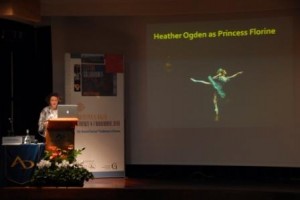
The princess remains one of the most popular icons in western culture. The prima ballerina is one of the most recognizable images of the princess and remains a unique silhouette in the world of western dance costume. In this paper I propose that the classical ballerina and her tutu perform an inseparable duet on the stage. While the ballerina constructs her identity both through the vocabulary of dance and the vocabulary of costume, much of her meaning would be lost in the eyes of the spectator if we did not have her classical tutu. An investigation of how clothes might be worn by a ballet dancer offers new insights to suggest what classical costume signifies in the ballet. I suggest that in the theatre the body becomes an optical effect accomplished by the clothes of the ballet; the dancer’s body animates or brings life to the tutu. Without the costume the ballerina can hardly become the princess. The tutu, as an icon of the ballet, forms an intimate relationship with her body and signifies her central role to the classical story as it unfolds on stage. Without the tutu, the rigours of the training and the articulation of the ballerina’s performance become abject, as does the tutu without a wearer, laid in a heap on the shelf.
Sara Piccolo Paci (Costume Historian & Anthropologist, Florence, Italy)
Dressing for the Last Ball: the Obscure Side of Dance – from the Rotentanz to Thriller”
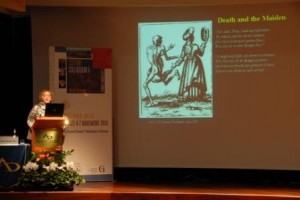 The link between Death and Dance is ancient and it can be retraced in many diverse cultures even if distant from each other in space and time. However there is a precise moment in western culture when the two concepts where tied in a peremptory way: between the XII and the XVI century specific texts and iconographies developed where Death, under the form of dancing skeletons, imposes its dance on mortals, whose identity is made visible through the dress they are wearing. From the pope to the priest, from the emperor to the noblewoman, from the merchant to the farmer to the young mother with child, everyone ‘dances’ with death while expressing their own vibrant vitality and questioning even us moderns on the sense of existence. Since the first mortal medieval poems – possibly inspired by the Latin “Vado Mori” – through some of the most famous iconographies – the Totentanz of Basilea and Lucerna and the xylography of Holbein -, to the attraction for the horrid and the macabre in modern film and video clip – like “Il Setitmo Sigillo”, “All that Jazz” and “Thriller” – we want to explore some anthropological and psychological aspects of dress that represent the ambiguous relationship between life and death, the meaning of the representation of dress such as the ‘last image’ of self and ‘fashion’ as ‘artificial’ and ‘final’ aspect of life itself.
The link between Death and Dance is ancient and it can be retraced in many diverse cultures even if distant from each other in space and time. However there is a precise moment in western culture when the two concepts where tied in a peremptory way: between the XII and the XVI century specific texts and iconographies developed where Death, under the form of dancing skeletons, imposes its dance on mortals, whose identity is made visible through the dress they are wearing. From the pope to the priest, from the emperor to the noblewoman, from the merchant to the farmer to the young mother with child, everyone ‘dances’ with death while expressing their own vibrant vitality and questioning even us moderns on the sense of existence. Since the first mortal medieval poems – possibly inspired by the Latin “Vado Mori” – through some of the most famous iconographies – the Totentanz of Basilea and Lucerna and the xylography of Holbein -, to the attraction for the horrid and the macabre in modern film and video clip – like “Il Setitmo Sigillo”, “All that Jazz” and “Thriller” – we want to explore some anthropological and psychological aspects of dress that represent the ambiguous relationship between life and death, the meaning of the representation of dress such as the ‘last image’ of self and ‘fashion’ as ‘artificial’ and ‘final’ aspect of life itself.
Marco Raffa (Giornalista, Genova, Italy)
Costume in Dance and History: Reconstruction Theories
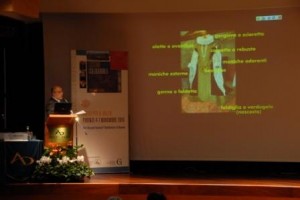
The intention of combining research on the costumes and dress of the medieval and late Renaissance with the use of costumes reconstructed for shows and historic events led him to develop a method of analyzing the sources – miniatures, engravings, frescos, paintings, inventories, and where possible, original artifacts – to then determine the reconstruction techniques using modern materials and methods. The same clothes should be wearable and also allow for a non-static use, such as that required for dance choreography which, in every era examined, provides specific steps and movements and – especially for the dress-armour of Spanish women’s fashion of the early seventeenth century – must then be “interpreted” through the filter of the clothing. He studied the portraits of Genoese ladies of the seventeenth century painted by Rubens and Van Dyck, or the engravings in the dance treatise “Le Gratie d’Amore ” from 1602, reconstructing some of them using the philosophy of the period – examining “verdugale”, “Faldetta”, and “giupone” sleeves that adorned the costume and hung down low – also creating the decorative elements – braid, embroidery, jewels applied to the fabric – and complimented with the typical elements of the period: ruffed collars, manicelli, head jewelry, made respecting the types and styles which, although only a few decades apart, varied significantly. The execution of the costumes had to respect the visual and tactile characteristics of the fabrics and accessories, but at the same time be “possible,” made with materials available on the market or by hand, and reusable, without constant readjustments for concerts and shows.
Fiona Reilly (Costume Designer, Academic & Historian, National Institute of Dramatic Arts, Sydney, Australia)
Dance Costume as an Expression of Culture: the Co-existence and Merging of European and Aboriginal Inspired Dance Costume in Australia
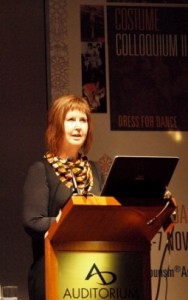 The history of dance in Australia spans millennia and to-day reflects contradictions that make up Australia’s cultural landscape. These contradictions are the inspiration behind a paper which will examine the work of two Australian costume designers who each personify a facet of Australian dance design – Kristian Fredrikson and Jennifer Irwin. Kristian Fredrikson (1945 – 2005) could be called ‘a European gentleman in the antipodes’. His cultural references were deeply rooted in the European tradition. He was brought up on Judaeo – Christian legends, British and European folklore and was steeped in the arts of the ‘homeland’. His work was deeply sensual and in later years an oriental vibrancy was evident, reflecting the way in which Australia now turns its face to Asia. Fredrikson designed extensively for two companies in particular – the Australian Ballet and Sydney Dance Company and the paper would track the development in costume of his influences as the Australian cultural landscape changes. In contrast, Jennifer Irwin (1958 – ), who started her dance career as a maker of Fredrikson’s costumes, has moved to embrace Australia’s indigenous culture. She has worked as the costume designer for Bangarra (Australia’s national Aboriginal and Torres Strait Islander dance company) as well as designing cross- cultural works for the Australian Ballet. Her world is the world of ochre, dust and clay where Stravinsky’s “Rites of Spring” merges Europe with the outback. The paper will examine the designers’ influences and their convergences. It will look at the way in which each creates costumes of great poetry and imagination but one is of the air (Fredrikson in the European ballet tradition) and one of the earth (Irwin in the Australian dance idiom). Each is also renowned for their use of textures which are achieved through entirely different approaches.
The history of dance in Australia spans millennia and to-day reflects contradictions that make up Australia’s cultural landscape. These contradictions are the inspiration behind a paper which will examine the work of two Australian costume designers who each personify a facet of Australian dance design – Kristian Fredrikson and Jennifer Irwin. Kristian Fredrikson (1945 – 2005) could be called ‘a European gentleman in the antipodes’. His cultural references were deeply rooted in the European tradition. He was brought up on Judaeo – Christian legends, British and European folklore and was steeped in the arts of the ‘homeland’. His work was deeply sensual and in later years an oriental vibrancy was evident, reflecting the way in which Australia now turns its face to Asia. Fredrikson designed extensively for two companies in particular – the Australian Ballet and Sydney Dance Company and the paper would track the development in costume of his influences as the Australian cultural landscape changes. In contrast, Jennifer Irwin (1958 – ), who started her dance career as a maker of Fredrikson’s costumes, has moved to embrace Australia’s indigenous culture. She has worked as the costume designer for Bangarra (Australia’s national Aboriginal and Torres Strait Islander dance company) as well as designing cross- cultural works for the Australian Ballet. Her world is the world of ochre, dust and clay where Stravinsky’s “Rites of Spring” merges Europe with the outback. The paper will examine the designers’ influences and their convergences. It will look at the way in which each creates costumes of great poetry and imagination but one is of the air (Fredrikson in the European ballet tradition) and one of the earth (Irwin in the Australian dance idiom). Each is also renowned for their use of textures which are achieved through entirely different approaches.
Maria Paola Ruffino (Curator, Palazzo Madama – Museo civico d’Arte Antica di Torino, Turin, Italy)
with Thessy Schoenholzer Nichols (Adjunct Professor of Costume Studies and Design Polimoda, Florence, Italy)
A Seventeenth Century Doublet ”for Dance” from the House of Savoy
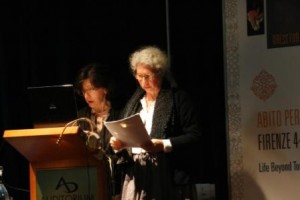 From the storerooms of the Madama Palace in Turin a doublet from the seventeenth century of ivory colored satin from the court of the dukes of Savoia, has recently emerged. The thick embroidery of the same color that entirely covers the doublet, repeatedly presents Savoia laces and roses. Today it presents itself lacking finishing, but the detailed analysis of the assemblage and historic and iconographic research can lead to the hypothesis that it is a theatrical dress, as traditionally said to be worn by Cristina di Francia, created for one of the ballets staged for the court festivities in Turin. The same members of court dressed in beautiful costumes recited to the musical renditions of Filippo d’Aglie’. Albums with thumbnail sketches created by the secretary and court calligrapher Giovanni Tommaso Borgonio, transmit the memory of these recitals. Their study has already allowed the identification of two moments of the doublet history: its first assemblage, with a back opening laced with ties and loops (that was later followed by the frontal fastening and the creation of circular eyelets on the back) that required assistance for dressing. The reconstruction of a pattern will facilitate tracing its modifications and it will be possible to virtually reconstruct even its first stage of creation, that today represents parts that possibly belong to another garment of the set, probably the breeches.
From the storerooms of the Madama Palace in Turin a doublet from the seventeenth century of ivory colored satin from the court of the dukes of Savoia, has recently emerged. The thick embroidery of the same color that entirely covers the doublet, repeatedly presents Savoia laces and roses. Today it presents itself lacking finishing, but the detailed analysis of the assemblage and historic and iconographic research can lead to the hypothesis that it is a theatrical dress, as traditionally said to be worn by Cristina di Francia, created for one of the ballets staged for the court festivities in Turin. The same members of court dressed in beautiful costumes recited to the musical renditions of Filippo d’Aglie’. Albums with thumbnail sketches created by the secretary and court calligrapher Giovanni Tommaso Borgonio, transmit the memory of these recitals. Their study has already allowed the identification of two moments of the doublet history: its first assemblage, with a back opening laced with ties and loops (that was later followed by the frontal fastening and the creation of circular eyelets on the back) that required assistance for dressing. The reconstruction of a pattern will facilitate tracing its modifications and it will be possible to virtually reconstruct even its first stage of creation, that today represents parts that possibly belong to another garment of the set, probably the breeches.
Katarina Nina Simoncic (Assistant professor of Clothing Design and Textiles, University of Zagreb, Croatia)
Croatian Dance Costume in the 19th Century: Symbol of Social and Political Changes in Zagreb
Dance costume in this paper is primarily examined as a symbol of political and social changes in the 19th century Zagreb, Croatia. Popular dances of 19th century Europe and Zagreb had a significant influence on the form of a dance costume; however fashion and anti-fashion influences also played a significant part. In the first half of the 19th century, as national consciousness was rising, dance costume with anti-fashion elements, i.e. elements of traditional clothing, becomes a characteristic of national awakening and ideology. In that respect, dance costume is primarily marked by political affiliation and patriotism, incorporating elements of the Croatian national costume in the fashion dance form. At the end of the 19th century, Zagreb is experiencing progress in textile industry, which had a strong effect on the dance costume. The location of Zagreb, as part of the Austro- Hungarian Empire, determines fashion influences coming from Vienna and Paris. The dance floor becomes a place where young ladies are presented, ready for marriage and looking for a wealthy match, while their dance costumes showed their financial status. By the end of the 19th century, national affiliation and patriotism ceased to be the symbols of the dance costume, instead it become a means of promotion of young girls. This paper focuses on a research that has been conducted in various archives of Zagreb, libraries and museums. Results are based on analysis and comparison of 19th century press, preserved dance costumes, fashion illustrations, photographs, etchings and paintings of that time.
Nina Tarasova (Curator of Costume, The State Hermitage Museum, St. Petersburg, Russia)
Dress-code of the Russian Court: Costumes for Balls and Masquerades at the State Hermitage Museum
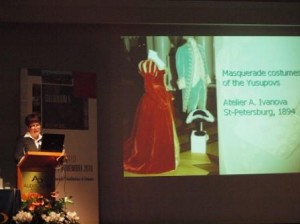 The unique collection of Russian fabrics, costumes and accessories at the State Hermitage Museum comprises over 22 000 exhibits. The collection structure provides wide research opportunities, allowing us to investigate many aspects of history of costumes in Russia, including questions of the formation of tradition and specific character of Russian ball costumes. Balls and masquerades were – along with official ceremonies – the most important and visually stunning elements of life at the Russian court. Leading architects, artists, musicians and costume designers were involved in their organization and design. As the culmination of court life, they represented, as it were, «an image of the Empire». In the winter of 1903 the grandiose fancy ball took place in the Winter Palace – the main Imperial Residence of Russia. The idea to hold this ball belonged to the last Russian Empress Alexandra Feodorovna. Almost 400 visitors dressed in fancy costumes in the style of Russian clothes of the 17th century have been invited to the palace. Only a few costumes from that masquerade, which turned out to be the last Ball of the Imperial Russia, miraculously survived after the October Revolution. They entered the collection of the State Hermitage Museum in 1941, some being in an extremely poor condition. Today, the demonstration of the costumes of the 1903 Ball is possible owing to the Hermitage curators and textiles conservators.
The unique collection of Russian fabrics, costumes and accessories at the State Hermitage Museum comprises over 22 000 exhibits. The collection structure provides wide research opportunities, allowing us to investigate many aspects of history of costumes in Russia, including questions of the formation of tradition and specific character of Russian ball costumes. Balls and masquerades were – along with official ceremonies – the most important and visually stunning elements of life at the Russian court. Leading architects, artists, musicians and costume designers were involved in their organization and design. As the culmination of court life, they represented, as it were, «an image of the Empire». In the winter of 1903 the grandiose fancy ball took place in the Winter Palace – the main Imperial Residence of Russia. The idea to hold this ball belonged to the last Russian Empress Alexandra Feodorovna. Almost 400 visitors dressed in fancy costumes in the style of Russian clothes of the 17th century have been invited to the palace. Only a few costumes from that masquerade, which turned out to be the last Ball of the Imperial Russia, miraculously survived after the October Revolution. They entered the collection of the State Hermitage Museum in 1941, some being in an extremely poor condition. Today, the demonstration of the costumes of the 1903 Ball is possible owing to the Hermitage curators and textiles conservators.
Corinne Thépaut-Cabasset (Researcher of History and Art History at Versailles Palace, France )
Dance Shopping in Paris in the Late 17th Century: Princely Dress for Dance in the European Courts
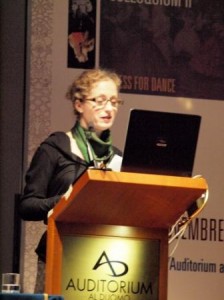
In the 1680’s, Paris is the high spot and the capital for arts training, and performances, Paris is the capital for fashion and luxury consumption. Studying the repertory of merchants in the late 17th century, comparing and crossing the travellers reports and the diplomatic correspondences with the unpublished archival resources as passports for luxuries goods is a very new and dynamic approach for the study of dance costume, its creation and economy. Every European prince ordered operas, ballets and masquerades to entertain the court life. And they focused on Paris in order to be provided by new and fine creation. Music and dance masters were asked to come, as tailors, hairdressers, embroiderers, etc… I have been excavated a number of documents from the foreign affairs archives in Paris and in Munich, showing a great example of a prince order for dance festivities. The passports kept in Paris give detailed lists of goods provides and send f from Paris to the Elector’s court in Munich between 1680-1690, and the Bavarian resident letters complete these lists and give the names of the merchants and artisans, the prices, the way they are bough and the way they travelled… Some of these documents may be enriched by costumes engravings and drawings kept in national collections. Other courts have asked to French artists and artisans to collaborate and create dance festivities for them, this franco-bavarian example is a sample of the tremendous unexplored archival material on this matter!
Tamara Tomic-Vajagic (PhD Candidate, Roehampton University, London – Visual Artist and Dance Historian/Writer, Belgrade, Serbia)
The Emergence of the Leotard Ballets and the Aesthetics of Practice-Clothes in Twentieth Century Dance
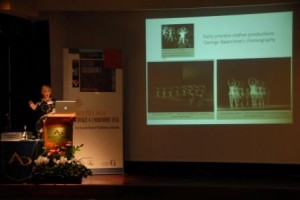 This paper examines the emergence and development of leotard and practice-clothes aesthetics in the twentieth-century ballet. This sub-genre of so-called abstract ballet has been made famous during the middle of the century, with George Balanchine’s 1951 revisions of his plotless ballets Concerto Barocco (1944) and The Four Temperaments (1946). But the roots and early imaginative appearances of leotard/unitard designs in place of theatrical costumes may be found in the early days of the twentieth century, throughout the repertory of Ballets Russes. Furthermore, the experimentational ideas in the Russian avant-garde theatre called for the liberation of the body (Souritz, 1990, 182) and have signaled a type of process-oriented exploration. This paper will look at the various early appearances of leotard costumes, and will analyze how these early ideas have influenced the emergence of the leotard ballet sub-genre during the middle of the century. Furthermore, the paper will analyze the historical relationship between these paired-down costumes and the performer’s stage experience and creative process in performance.
This paper examines the emergence and development of leotard and practice-clothes aesthetics in the twentieth-century ballet. This sub-genre of so-called abstract ballet has been made famous during the middle of the century, with George Balanchine’s 1951 revisions of his plotless ballets Concerto Barocco (1944) and The Four Temperaments (1946). But the roots and early imaginative appearances of leotard/unitard designs in place of theatrical costumes may be found in the early days of the twentieth century, throughout the repertory of Ballets Russes. Furthermore, the experimentational ideas in the Russian avant-garde theatre called for the liberation of the body (Souritz, 1990, 182) and have signaled a type of process-oriented exploration. This paper will look at the various early appearances of leotard costumes, and will analyze how these early ideas have influenced the emergence of the leotard ballet sub-genre during the middle of the century. Furthermore, the paper will analyze the historical relationship between these paired-down costumes and the performer’s stage experience and creative process in performance.
